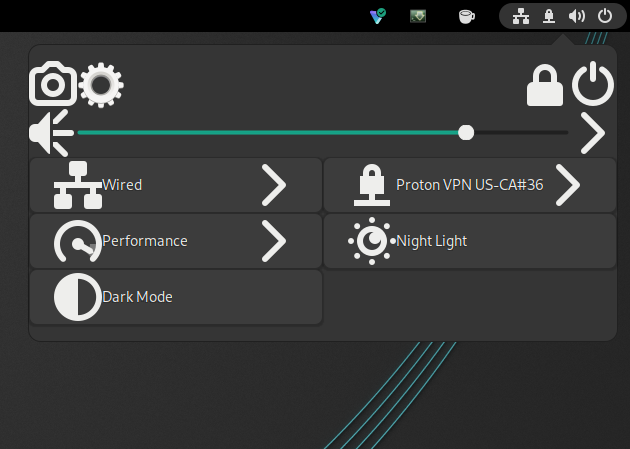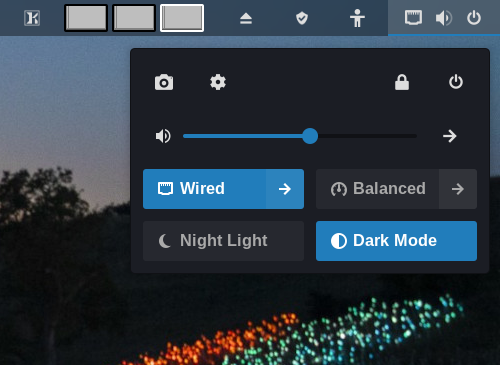Upgrade went smoothly.
The easiest way is to add the line add_binary '/usr/lib/ossl-modules/legacy.so' to plymouth-encrypt hook and regenerate ititrd.
GNOME stopped giving “safe to remove” notifications when disconnecting USB drives.
When will be a new iso image released ?
Newer than 21.3.7.
Thank you, I have made the change to config file, I will test it soon.
For the other strange ones like me, who will needs this information the file in question sits in:
(ofc the mkinitcpio can be run only after openssl is already updated)
/usr/lib/initcpio/install/plymouth-encrypt
and the change to be made is adding a line:
add_binary '/usr/lib/ossl-modules/legacy.so'
then run
mkinitcpio -P
or mkinitcpio -p linux<<version-of-your-choice>>
Then for check it if legacy.so appeared:
lsinitcpio /boot/initramfs-5.15-x86_64.img |grep legacy
-> usr/lib/ossl-modules/legacy.so
!!!UPDATE!!!
The solution works flawlessly, it has solved the issue.
Thank you again @openminded !
Sometimes it does flicker, sometimes it goes completely white. The weird thing is, it happened usually only in the evening after 8-10 hours of using my monitor. And what’s even odder, a full shutdown and reboot, unplugging everything, … doesn’t solve the issue, the monitor typically says goodbye again.
No nvidia graphics. If needed, I can post the output of inixi
Please update Latte-Dock to the current Git version. Its about time.
You are welcome, I just must note that you should remember that from now on every Plymouth update you should check if it has replaced the file you edited with a stock one without the above-mentioned line – just in case – and add it again if that happened. That’s if you stick with Whirlpool and have no plan to re-create LUKS volume from scratch w/o it, and if Plymouth hook is not updated by its maintainers the way we did it here.
Or a better approach: pinging @philm and @Yochanan to make a rebuild of Manjaro’s Plymouth package with that one-liner addition so it would be in sync with cryptsetup hooks in this regard.
I know it’s not the best solution. But it allows me to continue my work while waiting for my company to issue me an updated .ovpn file. And the most important thing is my solution doesn’t affect the overall system and is easy to revert back.
Just adding validity to the reporting at this point but I also get the following errors in bluetoothd (output from journalctl):
bluetoothd[745]: src/plugin.c:plugin_init() Failed to init vcp plugin
bluetoothd[745]: src/plugin.c:plugin_init() Failed to init mcp plugin
bluetoothd[745]: src/plugin.c:plugin_init() Failed to init bap plugin
The bluetooth headphone I use has been connecting fine but I have not been able to connect another pair that I have.
I’m having the same issue (on Gnome Desktop) where the quick menu is using huge icons all of sudden for some reason. I’m using the default adwaita themes (cursor, icons, and legacy applications all set to it. I’m also using the default fonts as far as I know I’ve never really changed them. I’ve attached a screenshot to show what it looks like. My system has been running Manjaro for a little over 4 years now. I have a laptop that has been running manjaro for about 2 years now and it is not exhibiting the same issue.

Normally the size matched the top bar iconsize and when you click on items like the shutdown the font seems to be the correct size so it seems to be an issue with the icons.
The other issue I’m experiencing is every time I open the application menu (Either by clicking the icon on the launch bar or pressing the hotkey to activate it the first letter I type when doing a search is always duplicated. I can then hit backspace and continue typing normally but 100% of the time no matter what character I press 2 of that character shows up in the search bar).
I was trying the 6.0.8 kernel but booted back into 5.19 with the same results on both issues. I haven’t tried booting into 5.15 or 5.10 kernel yet but I do have them installed but I don’t think this is kernel related more of a gnome thing.
There’s a solution here that also worked for me:
Fixed:

Thanks, that fixed the large icon issue for me as well.
The conflict was with manjaro-gdm-theme. So I’m guessing that is an older obsolete package that is no longer mantained?
The issue of 2 characters being typed whenever I first open the app launcher is still present though.
To be honest I’ve been using this manjaro install on my primary desktop now for over 4 years and think maybe it’s time to just do a nice clean wipe and reinstall things again. There has been so much change over the years and I’ve wanted to switch to a minimal install now that I understand the packages that I want to be running better. I’m sure over the years I’ve developed a decent amount of bloat that would be good to start over plus I really like using BTRFS on my laptop as the primary file system from a snapshot recovery perspective when trying out new things.
After GDM upgraded, I’m unable to login.
There is no password input field on my login screen, only up-right power control buttons appear.
Did anyone encounter the same issue after upgrade ?
[2022/11/18 Updates]
After change system language to “English” from “Chinese”, password input field is appear now. it’s a workaround to resolve this issue.
Update of my GNOME install went fine, but it looks like gnome.org is hard down. 80% of my extensions can’t update. Oh boy, perfect timing ![]()
Something similar happened to me but with SSDM/KDE:
I upgraded, rebooted and could not type my password; I had to shut down the computer from the login screen and the next reboot it worked ![]() .
.
